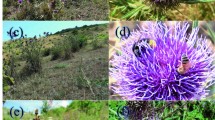Summary
Seasonal foraging patterns were investigated using six observation colonies maintained in the Okavango Delta, Botswana. Pollen collection, flight from the hive, and recruitment for pollen and nectar sources occurred throughout the 11 months of the study. However, the distribution of foraging activity throughout the day changed seasonally. Colonies emphasized recruitment for pollen sites throughout most of the year. Brood production occurred in all months except May, and there was a significant, positive correlation between the proportion of recruitment activity devoted to pollen sources and the amount of brood comb in the colonies. The seasonal foraging patterns ofscutellata in the Okavango were similar to those of Africanized honey bees in the neotropics. The extended foraging season and emphasis on pollen collection may be associated with the high swarming rates and migrational movements of tropical honey bees.
Similar content being viewed by others
References
Clauss, B., 1983.Bees and Beekeeping in Botswana, Ministry Agri., Botswana, 122 p.
Cobey, S. and S. Locke, 1986. The Africanized bee: A tour of Central America.Amer. Bee J. 126:434–440.
Danka, R. G., R. L. Hellmich, II, T. E. Rinderer and A. M. Collins, 1987. Diet-selection ecology of tropical and temporally adapted honey bees.Anim. Behav. 35:1858–1863.
Fletcher, D. J. C., 1978. The African bee,Apis mellifera adansonii, in Africa.Ann. Rev. Entomol. 23:151–171.
Gary, N. E., 1975. Activities and behavior of honey bees. In:The Hive and the Honey Bee. (Dadant and Sons, Eds.), Dadant and Sons, Hamilton, Illinois, pp. 185–264.
Griffiths, J. F., 1976.Climate and the environment. Westview Press, Boulder, Colorado.
McNally, L. C. and S. S. Schneider, 1992. Seasonal cycles of growth, development and movement of the African honey bee,Apis mellifera scutellata, in Africa.Ins. Soc. (in press).
Nightingale, J. M., 1976. Traditional beekeeping among Kenya tribes, and methods proposed for improvement and modernization. In:Apiculture in Tropical Climates (E. Crane, Ed.), International Bee Research Association, London, pp. 15–22.
Otis, G. W., 1982. Population biology of the Africanized honey bee. In:Social Insects in the Tropics. Proc. Symp. I.U.S.S.I. (P. Jaisson, Ed.), Cocoyoc, Mexico, pp. 209–219.
Otis, G. W., 1991. Population biology of the Africanized honey bee. In:The “African” Honey Bee (M. Spivak, D. J. C. Fletcher and M. D. Breed, Eds.), Westview Press, Boulder, Colorado, pp. 213–234.
Palgrave, K., 1984.Trees of Southern Afrika. C. Struik Publ, Cape Town, South Africa, 959 p.
Pesante, D., 1985. Africanized and European honey bee (Apis mellifera L.) pollen and nectar foraging behavior and honey production in the neotropics. Unpublished Ph.D. dissertation, Louisiana State Univ., Baton Rouge.
Pesante, D., T. E. Rinderer and A. M. Collins, 1987. Differential pollen collection by Africanized and European honeybees in Venezuela.J. Apic. Res. 26:24–29.
Rinderer, T. E., 1988. Evolutionary aspects of the Africanization of honey-bee populations in the Americas. In:Africanized Honey Bees and Bee Mites (G. R. Needham, R. E. Page, Jr., M. Delfinado-Baker and C. Bowman, Eds.), Westview Press, Boulder, Colorado, pp. 13–28.
Rinderer, T. E. and A. M. Collins, 1991. Foraging behavior and honey production. In:The“African” Honey Bee (M. Spivak, D. J. C. Fletcher, and M. D. Breed, Eds.), Westview Press, Boulder, Colorado, pp. 235–258.
Roubik, D. W., 1989.Ecology and natural history of tropical bees. Cambridge Univ. Press, Cambridge, Massachusetts. 514 pp.
Roubik, D. W. and S. L. Buchmann, 1984. Nectar selection byMelipona andApis mellifera (Hymenoptera: Apidae) and the ecology and nectar intake by bee colonies in a tropical forest.Oecologia 61:1–10.
Schneider, S. S., 1989. Spatial foraging patterns of the African honey bee,Apis mellifera scutellata.J. Insect Behav. 2:505–521.
Schneider, S. S., 1990a. Nest characteristics and recruitment behavior of absconding colonies of the African honey bee,Apis mellifera scutellata, in Africa.J. Insect Behav. 3:225–240.
Schneider, S. S., 1990b. Queen behavior and worker-queen interactions in absconding and swarming colonies of the African honey bee,Apis mellifera scutellata (Hymenoptera: Apidae).J. Kansas Entomol. Soc. 63:179–186.
Schneider, S. and R. Blyther, 1988. The habitat and nesting biology of the African honey bee,Apis mellifera scutellata, in the Okavango River Delta, Botswana, Africa.Ins. Soc. 35:167–181.
Seeley, T. D., 1985.Honeybee Ecology. Princeton Univ. Press, New Jersey, 201 pp.
Silberrad, R., 1976.Bee-keeping in Zambia. Apimondia, Bucharest, 74 pp.
Sinclair, A. R. E., 1983. The function of distance movements in vertebrates. In:The Ecology of Animal Movement (R. Swingland and P. J. Greenwood, Eds.), Clarendon Press, Oxford, pp. 240–258.
Visscher, P. K. and T. D. Seeley, 1982. Foraging strategy of honeybee colonies in a temperate deciduous forest.Ecology 63:1790–1801.
Von Frisch, K., 1967.Dance Language and Orientation of the Bees. Harvard Univ. Press, Cambridge, Massachusetts, 566 p.
Winston, M. L., 1987.The Biology of the Honey Bee. Harvard Univ. Press, Cambridge, Massachusetts, 281 p.
Winston, M. L., 1980. Seasonal patterns of brood rearing and worker longevity in colonies of the Africanized honey bee (Hymenoptera: Apidae) in South America.J. Kansas Entomol. Soc. 53:157–165.
Winston, M. L., G. W. Otis and O. R. Taylor, Jr., 1979. Absconding behaviour of the Africanized honeybee in South America.J. Apic. Res. 18:85–94.
Winston, M. L., O. R. Taylor and G. W. Otis, 1983. Some differences between temperate European and tropical African and South American honeybees.Bee World 64:12–21.
Author information
Authors and Affiliations
Rights and permissions
About this article
Cite this article
Schneider, S.S., McNally, L.C. Seasonal patterns of foraging activity in colonies of the African honey bee,Apis mellifera scutellata, in Africa. Ins. Soc 39, 181–193 (1992). https://doi.org/10.1007/BF01249293
Received:
Revised:
Accepted:
Issue Date:
DOI: https://doi.org/10.1007/BF01249293




